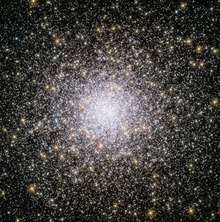NGC 362
| NGC 362 | |
|---|---|
|
False-color image of NGC 362 by GALEX; Credit: NASA/JPL/Caltech/University of Virginia/R. Schiavon (Univ. of Virginia) | |
| Observation data | |
| Class | III[1] |
| Constellation | Tucana |
| Right ascension | 01h 03m 14.26s[2] |
| Declination | −70° 50′ 55.6″[2] |
| Distance | 27.7 kly (8.5 kpc)[3] |
| Apparent magnitude (V) | 6.4 |
| Apparent dimensions (V) | 12.9′ |
| Physical characteristics | |
| Metallicity | = –1.09[4] dex |
| Estimated age | 10.37 Gyr[4] |
NGC 362 (Caldwell 104) is a globular cluster located in the constellation Tucana in the Southern Hemisphere, slightly north of the Small Magellanic Cloud. It was discovered on August 1, 1826 by James Dunlop.[5] It is visible to the naked eye in dark skies, and is an impressive sight in a telescope, although it is somewhat overshadowed by its larger and brighter neighbour 47 Tucanae.[6]

The stars of NGC 362 have an average metallicity higher than the stars in most globulars. This implies that NGC 362 is a relatively young globular cluster.[6] It also has an overabundance of binary stars, and an exceptionally tight core 13 light-years in diameter.[6] The orbit of NGC 362 is highly eccentric, taking it to within 3,260 light-years of the galactic center.[6]
See also
References
- ↑ Shapley, Harlow; Sawyer, Helen B. (August 1927), "A Classification of Globular Clusters", Harvard College Observatory Bulletin (849): 11–14, Bibcode:1927BHarO.849...11S.
- 1 2 Goldsbury, Ryan; et al. (December 2010), "The ACS Survey of Galactic Globular Clusters. X. New Determinations of Centers for 65 Clusters", The Astronomical Journal, 140 (6): 1830–1837, Bibcode:2010AJ....140.1830G, arXiv:1008.2755
 , doi:10.1088/0004-6256/140/6/1830.
, doi:10.1088/0004-6256/140/6/1830. - ↑ Paust, Nathaniel E. Q.; et al. (February 2010), "The ACS Survey of Galactic Globular Clusters. VIII. Effects of Environment on Globular Cluster Global Mass Functions", The Astronomical Journal, 139 (2): 476–491, Bibcode:2010AJ....139..476P, doi:10.1088/0004-6256/139/2/476.
- 1 2 Forbes, Duncan A.; Bridges, Terry (May 2010), "Accreted versus in situ Milky Way globular clusters", Monthly Notices of the Royal Astronomical Society, 404 (3): 1203–1214, Bibcode:2010MNRAS.404.1203F, arXiv:1001.4289
 , doi:10.1111/j.1365-2966.2010.16373.x.
, doi:10.1111/j.1365-2966.2010.16373.x. - ↑ "NGC 362". SEDS. Retrieved 28 June 2015.
- 1 2 3 4 O'Meara, Stephen James (2003). Deep Sky Companions: The Caldwell Objects. Cambridge University Press. pp. 409–412. ISBN 9780521827966.
External links
- SIMBAD: NGC 362
- Astrosurf: NGC 362
- Galactic Globular Clusters Database: NGC 362
- Galaxy Evolution Explorer Spies Band of Stars
